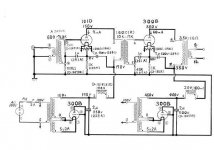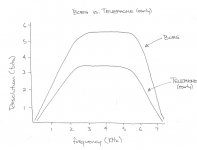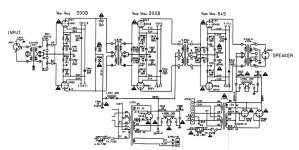For me it is the opposite. I have that choice (so do you by the way ;-)) and would never use SS...why add noise that you'd have to filter out again with a snubber or an extra LC/RC network? The only thing that might improve soundwize with SS rectification is the perceived BASS...but I have no problem with my bass...If given a choice I'd always use SS...
A good sounding amp starts with a good psu! Why wreck it from the outset?

Excerpt from http://www.nutshellhifi.com/triode1.html
"Matt Kamna also demonstrated a technique for zooming in on the waveform on the power-transformer secondary (about 10V/div on the scope screen). The rough appearance around the zero-crossing was very obvious with solid-state diodes. HEXFRED's gave a small improvement, but conventional tube rectifiers looked much smoother, and the TV damper diodes were by far the smoothest of all. So even in low-current preamp applications, TV damper diodes give the least noise. I know from experience in the Tektronix Spectrum Analyzer division that it's much easier to eliminate noise at the source than filter it afterward. If there was an even quieter device, I'd use that, but as far as I know, TV damper diodes are the quietest from the viewpoint of switching noise. Considering that the main B+ supply is switching five hundred volts, this is not a small consideration, since switch-noise is radiated in all directions, into the B+ supply, the interior of the chassis, and back into the power cord. "
RCA 82 was the best rectifier I ever had the pleasure to listen to.
I am after some obscure Nazi Era mesh rectifiers from Tele with 3rdReich stamps on them. I hope I can locate at least one. Sadly only enough for preamps. At least their oddball bases can be still found...But talking for real, available tubes, Emission Labs 274A is the best, but the price is ...ouch!
The resistor was only a 100Ohm one to slow start each charge cycle (avoiding charge peaks and associate spectral pollution), I use 3 toroid chokes in a pyramid capacitance (3:1:3) cap-choke configuration.
I am after some obscure Nazi Era mesh rectifiers from Tele with 3rdReich stamps on them. I hope I can locate at least one. Sadly only enough for preamps. At least their oddball bases can be still found...But talking for real, available tubes, Emission Labs 274A is the best, but the price is ...ouch!
The resistor was only a 100Ohm one to slow start each charge cycle (avoiding charge peaks and associate spectral pollution), I use 3 toroid chokes in a pyramid capacitance (3:1:3) cap-choke configuration.
rdf said:
Isn't regulation only a factor if the circuit 'sees' the rectifier? Most of the tube PSUs I've seen here use R and/or L to drop the rectified voltage. In some multi-section cases it doesn't seem to matter much at all if the R is a tube or wirewound heating up the chassis internals.
Indeed. People who use resistance for filtering have far worse things to worry about.
Using RC circuits across diodes to damp ringing is also a bit uncomfortable to me - fully admitting I haven't done any comparing - after all the surprising simulations results of RC PS filtering. Achieving good suppression at frequencies higher than ~70 kHz with common components is hard.
Er, you can use common components to build a 10MHz radio transciever. 70kHz is to 10MHz what DC is to 60Hz. Well, not quite, but it's a pretty far sight nonetheless.
With the present amount of junk on the lines, and talk of powerline broadband on the way, just the thought of opening paths to the junk present on the secondary is unappealing but I'm sure there's a way to handle it.
I believe that if it's there, it can be cleaned up for use with *anything*. If you have a transformer with insufficient regulation, you'll have to resort to an active regulator (and the voltage drop) to clean it up, but it can be done. Noise is super easy to filter since compared to DC... well, yeah. In fact the ONLY reason HF hash can get into the audio path is bad wiring, since a PSU filter is a LPF. (Granted, parasitic capacitance on the filter choke can help a little.)
UncleNed said:
Unless you use a gas rectifier and/or a choke input power supply. Gas rectifiers have a relatively small & constant voltage drop, that's why old tube testers use them.
Ah yes-- of course!
I'd think that in a preamp (which normally has a constant current draw) with decently filtered B+ , the choice of rectifier and the presence of a regulated power supply (or lack thereof) would be immaterial.
Indeed. Electrically, it looks good. As long as you don't leave class A, anyway.
Anything SE into speakers that aren't horns is probably going to get you some crunchies...
I'm not one to judge
But you have a business to maintain, too.
Tim
Sch3mat1c said:Er, you can use common components to build a 10MHz radio transciever. 70kHz is to 10MHz what DC is to 60Hz. Well, not quite, but it's a pretty far sight nonetheless.
Tim
True but HF design isn't trivial either and capacitors in a circuit can be designed to operate past their self-resonance as inductors. 10 MHz is ironically close to the frequency a simulation showed the rejection of an ASC oil cap + R multisection power supply went to zero because of the cascaded effect of capacitor self-resonances. (I never could figure out why it was 10 MHZ, the 40 uF ASC caps go inductive around 80 kHz. The few electrolytics I tested were much worse, 40-50 kHz. There's an excellent thread in the Chipamp forum on this.)
Again, without much experience listening to different versions all I can claim is I think I heard an improvement from optimized RC bypassing of the ASCs to achieve better 'paper' rejection. Achieving that decent 'paper' performance over a wide range of RF frequencies was the hard part.
Originally posted by analog_sa
The 5AR4 is a very poor sounding rectifier. Can't blame anyone if they don't much prefer it to hexfreds.
Recommendations appreciated.
Here is a schematic of a SE 300b amp (Brought to my attention by Thorsten I think). Have not done it myself yet.
 . Apparently damper diodes were not used by European manufacturers in TV's. Because when colour tv came to europe they had switched to SS allready, or something like that.
. Apparently damper diodes were not used by European manufacturers in TV's. Because when colour tv came to europe they had switched to SS allready, or something like that.
I found this post http://www.diyaudio.com/forums/showthread.php?postid=579893#post579893
If you factor out the filament supply and socket/top-cap they (damper diodes) are cheaper than the high voltage Cree Schottky's But of what importance is cost in hifi? Irrelevant..
But of what importance is cost in hifi? Irrelevant..
I have no idea. I expect a North American person to knowDoes anyone know why damper diodes create less switching noise than regular rectifier diodes?
I found this post http://www.diyaudio.com/forums/showthread.php?postid=579893#post579893
They are manufactured with a special cathode coating process they prevents cathode stripping under heavy pulse conditions.
If you factor out the filament supply and socket/top-cap they (damper diodes) are cheaper than the high voltage Cree Schottky's
Attachments
SY said:A diode-connected DHT will have a high impedance and low perveance (i.e., high voltage drop). Not exactly quality factors in rectification/regulation.
Well, the I/V curve follows the Vg = 0V curve, more perveance still if you connect G to P. (In this arrangement, a single 12AU7 triode runs 110mA at 20V; grid current is slightly greater than plate current!)
But yes, still quite ludicrous. Even more ludicrous than using 300Bs for output. Well, almost...
Tim
SY said:Tom, if you or anyone else wants to lend me a DHT, I'll run noise, source Z, and drop versus current.
Hey, that's a deal! I have a couple of 572-3s out of commission. Send me a pm with your address and I'll send you the tubes and a crackerjack surprise.
Hi,
I concur but....
When it comes to pure technical arguments we'd all be using semis for rectumrefrigeration, amplification and everything inbetween.
Most solid sweat devices look all dandy on paper and no doubt they do what they were designed to do rather well.
But audio? No way, Jose...
However, when it comes to using one's brain and a pair of healthy ears to design an audio amplifier all the engineering miracles in the world can't seem to come to grips with the fact you don't just glue super components together hoping they'll let the music through unslaughtered.
Sure you can apply bandaids to all kinds of things, worry about the loss of regulation of that PS in it's early stages but what for?
The applied bandaid is yet another set of components with its inherent potential to wreck the sound.
Does it really improve things, has that RFI really disapeared into thin air?
Does that lousy diode suddenly swing?
Regulation of a rectifier/transformer?
Who gives a damn, short of regulating the whole shebang, yes that works too, the best sounding amps I ever heard invariably had vacuum tube rectification, chokes and looked generally as Einsteinian simple as could be.
Nonetheless, simple as these amps may look, they still took sometimes years of painstaking evaluation to get just about right.
You wouldn't believe it when I tell you that such evaluation includes powertransformers, chokes, OPTs, tubes, sockets, in short every single thing that goes in there is critically listened to down to the choice of chassis material.
Than, only than can you say that you have yourself an amplifier worth its salt.
Prior to that you have an electronic circuit, one that works I'd hope, but an amplifier it hardly is.
Some may say audio is a science but I'm far more inclined to say it's more of an art than it is a science..
The only thing science has done for the reproduction of music over the past fifty years is slashing it to bits and pieces and selling it back to the unsuspecting public...Some exceptions notwithstanding, bien entendu.
Interludium over,
A diode-connected DHT will have a high impedance and low perveance (i.e., high voltage drop). Not exactly quality factors in rectification/regulation.
I concur but....
When it comes to pure technical arguments we'd all be using semis for rectumrefrigeration, amplification and everything inbetween.
Most solid sweat devices look all dandy on paper and no doubt they do what they were designed to do rather well.
But audio? No way, Jose...
However, when it comes to using one's brain and a pair of healthy ears to design an audio amplifier all the engineering miracles in the world can't seem to come to grips with the fact you don't just glue super components together hoping they'll let the music through unslaughtered.
Sure you can apply bandaids to all kinds of things, worry about the loss of regulation of that PS in it's early stages but what for?
The applied bandaid is yet another set of components with its inherent potential to wreck the sound.
Does it really improve things, has that RFI really disapeared into thin air?
Does that lousy diode suddenly swing?
Regulation of a rectifier/transformer?
Who gives a damn, short of regulating the whole shebang, yes that works too, the best sounding amps I ever heard invariably had vacuum tube rectification, chokes and looked generally as Einsteinian simple as could be.
Nonetheless, simple as these amps may look, they still took sometimes years of painstaking evaluation to get just about right.
You wouldn't believe it when I tell you that such evaluation includes powertransformers, chokes, OPTs, tubes, sockets, in short every single thing that goes in there is critically listened to down to the choice of chassis material.
Than, only than can you say that you have yourself an amplifier worth its salt.
Prior to that you have an electronic circuit, one that works I'd hope, but an amplifier it hardly is.
Some may say audio is a science but I'm far more inclined to say it's more of an art than it is a science..
The only thing science has done for the reproduction of music over the past fifty years is slashing it to bits and pieces and selling it back to the unsuspecting public...Some exceptions notwithstanding, bien entendu.
Interludium over,
Has anyone tried DHTs as rectifiers?
Marantz have in T1.
when it comes to using one's brain and a pair of healthy ears to design
I have it on good authority the Borg processes sound in 8 bits.
An excellent post Frank.
analog_sa said:I have it on good authority the Borg processes sound in 8 bits.
Think it's that high? Borg are just-post-telephony, aren't they?
analog_sa said:Marantz have in T1.
Interesting, Marantz uses 845s to rectify the B+ for the 845 pp output. 845s have very low plate to filament capacitance of about 3.5pF.
The Italian manufacturer Viva also uses DHT rectifiers, including two 300Bs in the power supply of their preamp.
Attachments
- Status
- This old topic is closed. If you want to reopen this topic, contact a moderator using the "Report Post" button.
- Home
- Amplifiers
- Tubes / Valves
- tube rectifier


